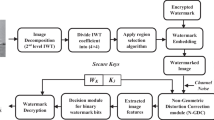Abstract
Audio recordings have been used as evidence for long times. Multimedia processing advancement makes it difficult to be completely sure about what is heard is the truth. This paper presents a promising approach for integrity verification of recorded audio signals using discrete cosine transform. This approach is based on self embedding concept which embeds block-based marks extracted from the same audio signal after being transformed into 2-D format into other blocks according to a specific algorithm. After the self-embedding process, the data is converted back into 1-D style which represents a marked audio signal. The 1-D audio signal is converted into a 2-D format and then converted back into a 1-D format using the popular lexicographic ordering scheme utilized in image processing. Reverse processes are executed to extract the verification marks from the audio signal throughout the integrity verification process. Based on the extracted audio signal properties, the integrity of the marked audio signal is evaluated. Different audio processing tasks and attacks are implemented to examine the suitability of the proposed algorithm for verifying the integrity of high-confidentiality recorded audio data. The results show that the efficient ability of the proposed approach to verify integrity and detect attacks.

















Similar content being viewed by others
References
Ahmed, N., Natarajan, T., & Rao, K. R. (1974). Discrete cosine transform. IEEE Transactions on Computers, C–23(1), 90–93. doi:10.1109/T-C.1974.223784.
Al-Haj, A., Bata, L., & Mohammad, A. (2009). Audio watermarking using wavelets, In: Proceedings of first international conference on networked digital technologies (pp. 398–403). NDT ‘09, July 28–31, 2009.
Bassia, P., Pitas, I., & Nikolaidis, N. (2001). Robust audio watermarking in the time domain. IEEE Transactions on Multimedia, 3(2), 232–241.
Can, Y. S., Alagoz, F., & Burus, M. E. (2014). A novel spread spectrum digital audio watermarking technique. Journal of Advances in Computer Networks, 2(1), 6–9.
Chang, W. H., & Chang, L. W. (2010). Semi-fragile watermarking for image authentication, localization, and recovery using Tchebichef moments. In: International symposium on IEEE communications and information technologies ( ISCIT).
Dittmann,J., Steinmetz, A., & Steinmetz, R. (1999). Content-based digital signature for motion pictures authentication and content-fragile watermarking. In: International conference on multimedia computing and systems, Florence, June 1999.
Dittmann, J. (2001) Content-fragile watermarking for image authentication. In: Proceedings of SPIE (Vol. 4314). Bellingham.
G´omez, E., Cano, P., de C. T. Gomes, L., Batlle, E., Bonnet, M. (2002) Mixed Watermarking-Fingerprinting Approach for Integrity Verification of Audio Recordings. In: International telecommunications symposium —ITS2002, Natal.
Khayam, S. A. (2003). The discrete cosine transform (DCT ): Theory and a pplication. Michigan State University, March 2003.
Kubichek, R. (1993). Mel-cepstral distance measure for objective speech quality assessment. In: Proceedings of the IEEE Pacific Rim conference on communications, computers and signal p rocessing (pp. 125–128).
Li, C.-T., & Yang, F.-M. (2003). One-dimensional neighborhood forming strategy for fragile watermarking. Journal of Electronic Imaging, 12(2), 284–291.
Liu, C., & Chen, O. (2004). Fragile speech watermarking scheme with recovering speech contents. In: The 2004 47th Midwest symposium on circuits and systems. MWSCAS’04 (Vol. 2, pp. II-165–II-168).
Lu, C., Liao, H., & Chen, L. (2000) Multipurpose audio watermarking. In: Proceedings 15th international conference on pattern recognition (Vol. 3, pp. 282–285), 2002.
Nassar, S. S., Ayad, N. M., Kollash, H. M., Faragallah, O. S., M. El-Bendary, M. A., & Abd-Elsamie, F. E. (2014) Image contents verification algorithm using transform domain techniques. International Journal of Computer Applications (0975–8887), 97(9).
Petrovic, R. (2005). Digital watermarks for audio integrity verification, Serbia and Montenegro, Nis, September 28–30, 2005.
Radharani, S., & Valarmathi, M. L. (2010). A study of watermarking scheme for image authentication. International Journal of Computer Applications, 2(4), 24–32.
Shaw, G. (2000) Digital document integrity. 8th ACM multimedia conference. Los Angeles, November 2000.
Shiva Kumar, K. B., Raja, K. B., Chhotaray, R. K., Pattnaik, S., (2010). Coherent Steganography using Segmentation and DCT, IEEE-978-1-4244-5967-4/10/$26.00.
Shoemaker, C. (2002). Hidden Bits: A Survey of Techniques for Digital Watermarking Independent Study EER-290. Prof Rudko, Spring 2002.
Tewfik, A. H. (2000). Digital watermarking, San Mercury News. August 14, 2000.
Wang, S., Sekey, A., & Gersho, A. (1992). An objective measure for predicting subjective quality of speech coders. IEEE Journal on Selected Areas in Communications, 10(5), 819–829.
Wu, C.-P., & Jay Kuo, C.-C. (2001). Speech content integrity verification integrated with ITU G.723.1 speech coding. In: IEEE international conference on information technology: Coding and c omputing (pp. 680–684). Las Vegas, April 2001.
Wu, C. & Jay Kuo, C.-C. (2002). Fragile speech watermarking for content integrity verification. In: IEEE international symposium on circuits and systems, 2002. ISCAS 2002 (Vol. 2, pp. II-436–II-439).
Yang, W., Benbouchta, M., & Yantorno, R. (1998). Performance of the modified bark spectral distortion as an objective speech quality measure. In: Proceedings of the IEEE international conf erence on acoustic, speech and signal processing (ICASSP ) (Vol. 1, pp. 541–544). Washington, May 1998.
Zhang, P., Xu, S., & Yang, H. (2012) Robust and transparent audio watermarking based on improved spread spectrum and psychoacoustic masking. In: Proceedings 2012 international conference on information science and technology ( ICIST) (pp. 640–643). March 23–25, 2012.
Author information
Authors and Affiliations
Corresponding author
Rights and permissions
About this article
Cite this article
Nassar, S.S., Ayad, N.M., Kelash, H.M. et al. Efficient audio integrity verification algorithm using discrete cosine transform. Int J Speech Technol 19, 1–8 (2016). https://doi.org/10.1007/s10772-015-9312-6
Received:
Accepted:
Published:
Issue Date:
DOI: https://doi.org/10.1007/s10772-015-9312-6




